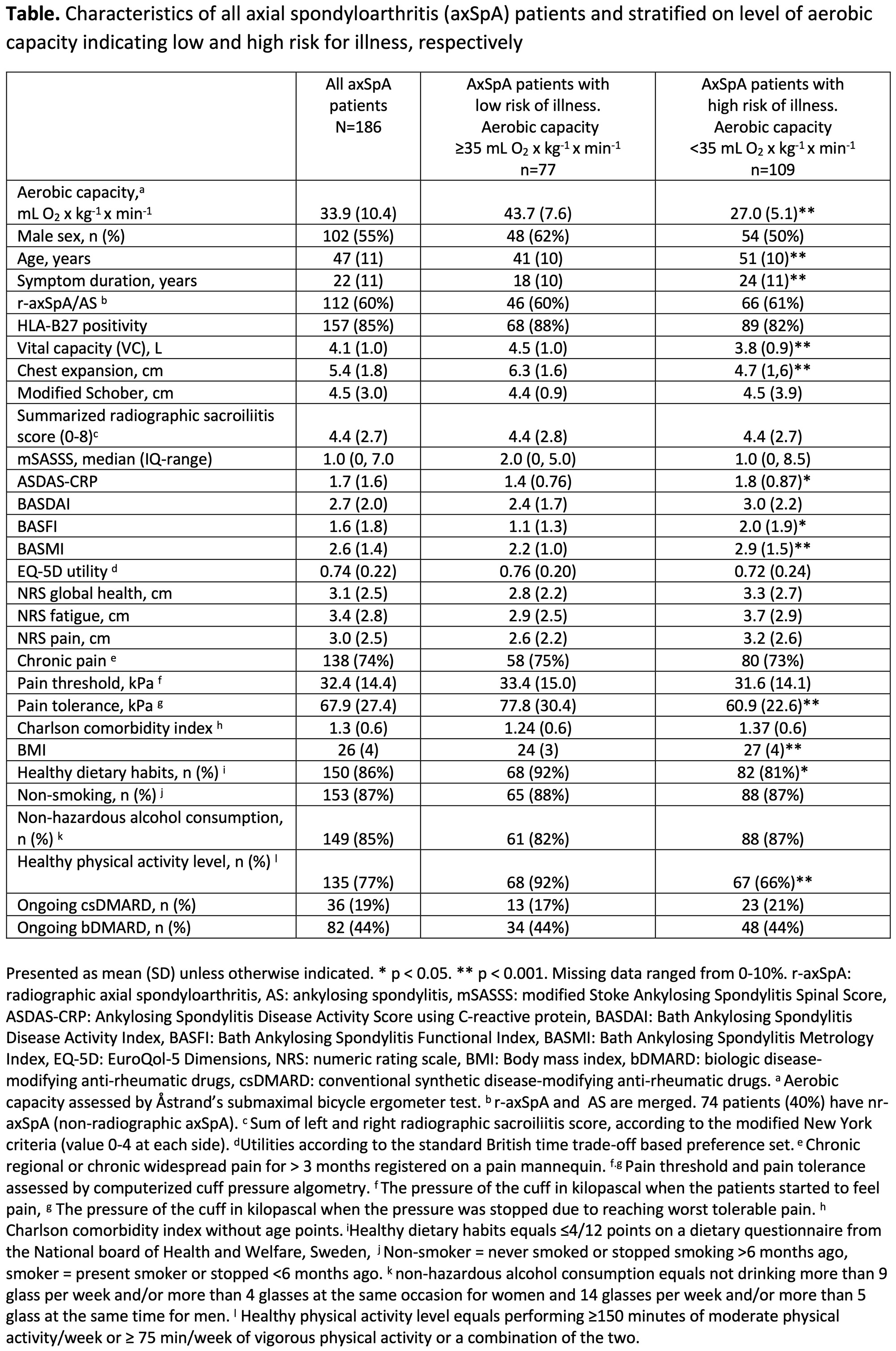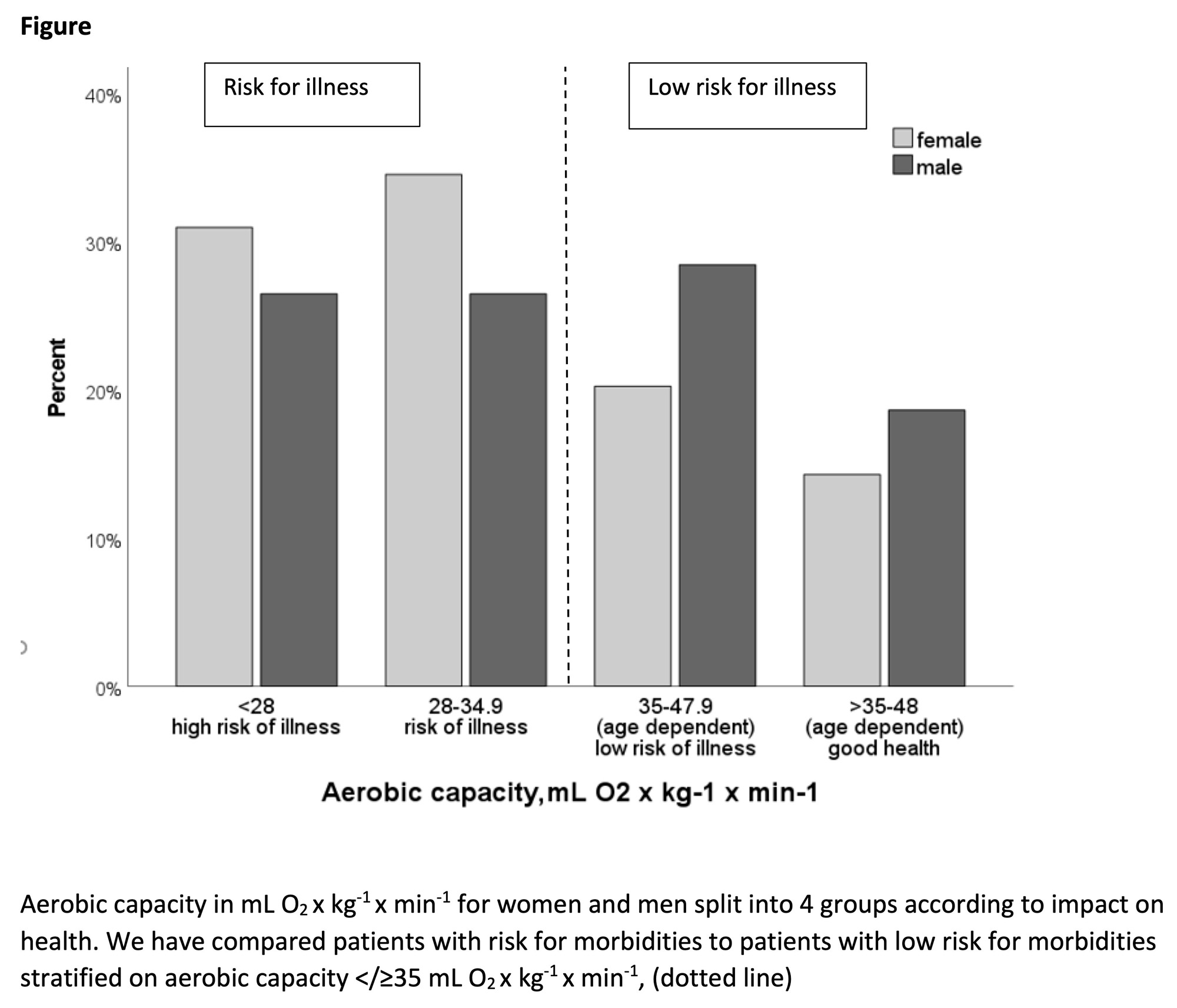Session Information
Session Type: Poster Session B
Session Time: 9:00AM-11:00AM
Background/Purpose: Physical activity is part of the treatment of axial spondyloarthritis (axSpA), but despite this almost half of the patients do not meet the required level of physical activity to promote health. (1)Low aerobic capacity (cardiorespiratory fitness) is an important risk factor for cardiovascular disease, morbidity, and mortality. (2) The aim of this study was to evaluate aerobic capacity in patients with axSpA, and to examine differences between patients with low versus high aerobic capacity.
Methods: Patients with clinical axSpA from a defined area of southern Sweden were cross-sectionally examined and classified as non-radiographic axSpA (nr-axSpA; ASAS criteria; n=74) or radiographic axSpA (r-axSpA; modified NY or ASAS criteria; n=112). Aerobic capacity was measured by a submaximal bicycle ergometer test (Åstrand). A value of >28 mL O2 x kg-1 x min-1 (mL O2) is associated with a reduced risk of all-cause mortality, and ≥35 mL O2 is estimated to be an acceptable level for health in the short term. For health in the long term, a value of 35.1 – 48 mL O2depending on age, is desirable. (4) Other assessments included spinal mobility, chest expansion, vital capacity (VC), pain sensitivity (by computerized cuff pressure algometry (3)), radiographic assessments (sacroiliac joints [SI-joints]/modified Stoke Ankylosing Spondylitis Spinal Score [mSASSS]), lifestyle habits, health-related quality of life, and standard axSpA outcome measures. Comparisons between patents with aerobic capacity ≥/< 35 mL O2 were performed by Student’s t-test/Chi-square test, Mann-Whitney U-test, as appropriate.
Results: Mean aerobic capacity was 33.9 mL O2, with no differences between nr-axSpA and r-axSpA or men and women (Figure). Only 17% displayed the desirable level of aerobic capacity for health in the long term, and 28% had an aerobic capacity of < 28 mL O2, indicating a high risk of illness. Patient characteristics, stratified on aerobic capacity ≥/< 35 mL O2 are presented in the Table. Patients with aerobic capacity ≥35 mL O2 were younger, had lower disease activity, better physical function, and spinal mobility. Aerobic capacity ≥35 mL O2 was further associated with better VC and chest expansion, and more healthy body mass index (BMI) and dietary habits, while mSASSS showed borderline significance (p=0.067). No associations were found between aerobic capacity (≥/<35 mL O2) and grade of radiographic changes in the SI-joints, global health, pain, fatigue, or health-related quality of life. Patients with aerobic capacity ≥35 mL O2 had higher pain tolerance, while chronic pain was equally common in both groups.
Conclusion: The majority of patients with established axSpA displayed an aerobic capacity indicating a high risk of morbidity. Better chest mobility and vital capacity, as well as healthy BMI and dietary habits were associated with higher aerobic capacity. These findings emphasize the importance of supporting patients with axSpA to a healthy lifestyle and improved aerobic capacity by physical exercise. References 1 Mogard. BMC Rheumatol. 2022;6:29 2 Harber. Prog Cardiovasc Dis. 2017;60:11–20 3 Mogard. J Rheumatol. 2021;48:1672–9 4 Ross. Circulation. 2016;134:e653–e699
To cite this abstract in AMA style:
Lindqvist E, Karlsson Wallman J, Sagard J, Olofsson T, Mogard E. Aerobic Capacity and Its Relation to Disease Characteristics and Lifestyle Habits in Patients with Axial Spondyloarthritis [abstract]. Arthritis Rheumatol. 2023; 75 (suppl 9). https://acrabstracts.org/abstract/aerobic-capacity-and-its-relation-to-disease-characteristics-and-lifestyle-habits-in-patients-with-axial-spondyloarthritis/. Accessed .« Back to ACR Convergence 2023
ACR Meeting Abstracts - https://acrabstracts.org/abstract/aerobic-capacity-and-its-relation-to-disease-characteristics-and-lifestyle-habits-in-patients-with-axial-spondyloarthritis/


